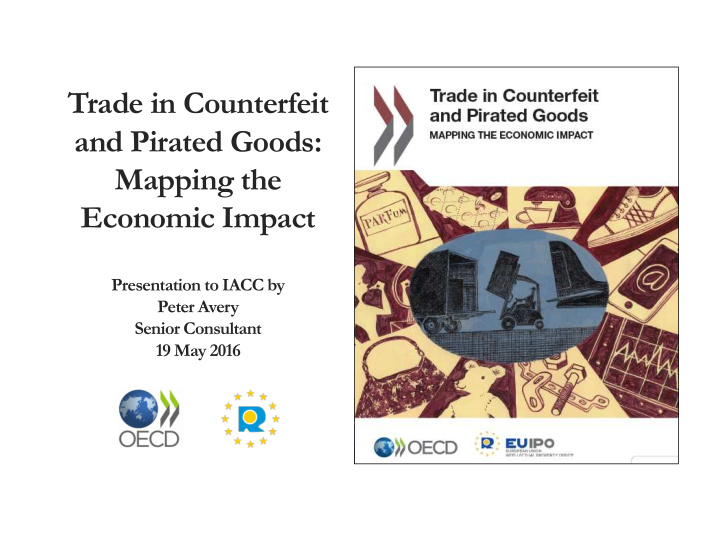



Trade in Counterfeit and Pirated Goods: Mapping the Economic Impact Presentation to IACC by Peter Avery Senior Consultant 19 May 2016
Joint project: OECD — EUIPO With excellent collaboration with: • World Customs Organization (WCO) • DG TAXUD of the European Commission • US Dept. of Homeland Security
The key question: What are the volumes, scope and trends of trade in counterfeit and pirated goods?
Why does “counterfeiting and piracy” matter? Rising economic importance of intangibles (ideas, brands, know-how…), including intellectual property rights means: Increasing incentives to counterfeit (“ free riding ”)
Why does “trade in counterfeit and pirated goods” matter? • Now revival of trade since the economic crisis; • Emergence of global value chains; • Booming e-commerce à … high focus on trade. Complex dynamics of counterfeit trade
We have analysed counterfeit trade using: • Customs data on seizures of fake goods; • Interviews with enforcement officials (customs, police) and industry experts; • OECD 2008 project experience .
Results “photographs” of counterfeit trade
In 2013 trade in fake goods was as much as USD 461 bn (up to 2.5%) of world trade.
In the EU: EUR 85 billion (USD 116 billion) (up to 5% of total EU imports). Developed countries are more targeted than other countries.
USD 461 billion… … combined GDP of Ireland and the Czech Republic … twice Apple’s yearly revenue.
Key results Worldwide EU € 85 € 338 billion billion (USD 116bn) of EU imports (USD 461bn ) Corresponds to 5% Trade in fake goods of total EU imports Corresponds to 2.5% of global trade
All economies and continents are involved, either as: * transit points of trade, or as * producing economies.
Where do fakes originate?
Middle income / emerging economies dominate (e.g. China). They have sufficient infrastructure, and productive and technological capabilities ...but They may not have sound institutional frameworks to combat counterfeiting.
Complex trade routes with many transit points: Large trade hubs including FTZs (e.g. HK, Singapore, Dubai) Countries with weak governance (e.g. Afghanistan, Syria)
Which products are concerned?
Fake… * high-end consumer luxury goods (watches, perfumes or leather goods) * business-to-business products (machines, chemicals, spare parts…) * ordinary consumer products (toys, pharmaceuticals, cosmetics and foodstuffs)
Any IP-protected product becomes a target for counterfeiters. Fresh strawberries, bananas, cinnamon or coconut oil.
Whose rights are being infringed?
Most brands are hit by counterfeiting. * Many are located in OECD countries; but * Chinese companies are also targeted. All innovative companies that rely on IP are at risk, no matter if they are in developed or in emerging economies.
Counterfeiting trends: transport Number of items per seizure Transport modes on average (2011-2013) 70% As a percentage of total seizures 60% 50% 40% 30% 20% 1 6 - 10 10% >10 1 - 5 0% Mail Air Sea Road Rail Other Pedestrian Counterfeit and pirated trade is mainly done in small shipments
Growth in small shipments (postage / express services) * Shrinking costs of express services * Booming e-commerce * For traffickers – a way to avoid detection and minimise the risks of sanctions
What are the next steps? • Robust results – starting points for building evidence-based policy responses • We are ready to act, and to provide evidence, and to advise our respective member countries. • Our intention: to continue our successful co-operation.
oe.cd/fake www.euipo.europa.eu/
Contacts Piotr.Stryszowski@oecd.org Nathan.Wajsman@euipo.europa.eu
Recommend
More recommend